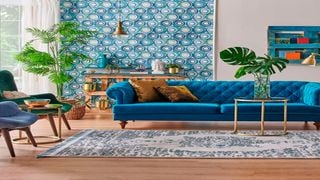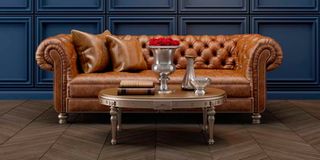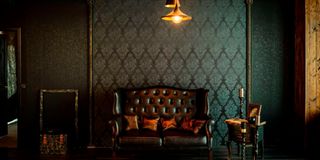
The popularity of home decor diminishes gradually given that replacing furniture and home accessories is expensive.
| PoolDN2
Premium
Out with the old, in with the new: These decor trends are staring at oblivion
What you need to know:
- Wooden hangings are beginning to feel outdated, and as a result, there is less demand for them in the market.
- It has become apparent that a fake green plant cannot replace a live one despite the resemblance.
Remember back when people covered their walls with long lace fabrics in the early 2000s? That is one long-forgotten decor trend. Trends come and go as circumstances around us change.
Many factors define these trends. The wall lace era for instance was probably in line with the quality of plaster work or affordability of wall paint back then, but over time, wall paint became more sophisticated and interior design got cleaner and refined, pushing homeowners to embrace bare walls.
As we start another year, we should expect new trends to crop up. It might be time to say goodbye to some old decor trends we've grown accustomed to. Unlike fashion, however, home decor trends do not change as fast. Their popularity diminishes gradually given that replacing furniture and home accessories is expensive. If you own any of these previously trendy pieces, there is always an alternative use for them. Read on to find out what to do with them:
Poufs
Ottomans have enjoyed undisputed reign in our homes for more than five years now. Perhaps it has to do with their versatility, a factor that boosted their popularity. They have been used as footrests, coffee tables, dressing table chairs and multifunctional storage units. Unfortunately, with the rise of home offices, bulky furniture is on its way out.
Every inch of available space is extremely valuable as people have to turn available rooms into multifunctional spaces. Poufs are quite bulky, and over the past one year, their popularity has reduced significantly.
If you have one of the good old ottomans, you may consider handing it down to a younger relative who is just starting out with no furniture. Alternatively, create a home for the piece in your bedroom.
Generic Art
Once upon a time, the art piece with three calabashes pouring into one another graced many homes in Kenya. Back then, generic art was the in-thing. Art was sold in shops and on the streets, but now homeowners are more informed and appreciative of real art.
Besides, artists are no longer confined in galleries and art studios. They market their work online and attract the attention of art enthusiasts. The rise of framed gallery walls (which are more meaningful) has also affected the popularity of generic art. We are seeing less and less of such art pieces and more unique pieces in the market.
If the generic art bug bit you when you were naively decorating your home, do not toss it out yet. Improvise the art's frames by mounting a mirror onto them. You might just be in need of an extra bathroom mirror.

Leather sofa and home decor.
Wooden Hangings
For some unknown reasons, we all thought it was cool to invest in big lettered hangings spelling the words, "home", "welcome" or "love". But after spending so much time working from home, a big hanging that says "welcome" becomes annoying after a few hours.
Wooden hangings are beginning to feel outdated, and as a result, there is less demand for them in the market. Unfortunately, they are difficult to recycle, but maybe in the future they will be trendy again. Try your luck and store them in a safe space. You may even hand them down to future generations as heirlooms one day.
Temporary Accessories
Back in the 80s and 90s, people bought a set of sofas that they planned to use until the end of time. In some households, children were not allowed to play in the house or even sit for too long on the sofas as a way to preserve them. And then people's incomes increased and consumerism peaked.
Nowadays, a big number of people tend to change furniture regularly, though there are rising concerns about sustainability and the impact it has on the environment, which shifts the way we shop for home decor items.
In 2018, the government banned logging, a move that subsequently affected availability and pricing of wooden furniture. There are also concerns over environmental degradation and people are jumping onto the bandwagon of saving the environment by shopping sustainably. Temporary accessories such as poor quality carpets, weak fabrics, temporary wall hangings and poorly-made furniture are likely to lose popularity in 2022.
Fake plants
This trend was recycled from the early 2000s after the pandemic confined us to our homes in 2020. People craved for nature and green spaces and started bringing the outdoors inside, and those who cannot keep anything alive opted for fake plants.
However, it has become apparent that a fake green plant cannot replace a live one despite the resemblance. Real plants purify the air, in addition, watering them and watching them grow or produce flowers has psychological and physical benefits.
A study published in the journal of Physiological Anthropology involving 24 participants proved that gardening real plants reduced stress levels significantly. The study divided the participants into two groups of 12. The first group was given a computer-related task while the second was tasked with repotting plants.
After the tasks, the researchers evaluated both semantic and physiological aspects such as heart rate and blood pressure of the participants. Gardening proved to be a natural stress reliever while the computer tasks spiked stress levels.
Simply put, a fake plant can only offer aesthetic value while collecting dust, but a real one offers life changing benefits. This fact has become apparent to many, hence the fall of fake plant decor.

Leather sofa and home decor.
Bean Bags
These pieces of furniture are the most impractical invention in home decor history. Unless you are significantly short, they offer very little support for the back and legs. At a glance, you'll imagine yourself sinking into them and feeling as though you are in the clouds. But once you sit on them, you realise just how unrelaxing they are.
Bean bags became popular in the early 2000s. They began as part of family home furniture. Guests would struggle to sit comfortably on them while maintaining their decency. Later, video gamers and single people (those without families) developed interest in them.
Gaming however became a profession rather than a hobby and these strangely shaped bags lost relevance. It is hard to spot a bean bag in a furniture store, and 2022 might be the year when they finally disappear from the home decor scene.
Wood Pallets
Wood pallet furniture was a great alternative to hardwood furniture after the government banned logging. Pallets have an appealing rustic appearance and are relatively affordable. When they hit the market in 2019, everybody rushed to get a piece. They were both in commercial and residential spaces and their popularity cut across different classes.
According to a study by researchers, Jonah Berger and Gael Le Mens, the faster an item becomes popular among the masses, the faster it will fall from grace. When "everybody" embraces something, the masses begin to perceive it as a fad and suddenly everyone tries to avoid it.
The two researchers based their study on the popularity of baby names within the last 100 years. They chose to use baby names as their basis because they are not influenced by the media or popular culture. The researchers interviewed expectant parents and they concluded that the more a baby name was used, the more expectant parents avoided it.
Neutral Tones
Have you noticed a sudden pop of colour in buildings, furniture stores and homes in general? The "grey era" seems to be coming to an end. Over the last several decades, people have confined their tastes to neutral colours with grey and brown taking the lead. But suddenly there is deep interest in bold colours and sometimes a mixture of neutral and bold.
Perhaps, after the pandemic hit, life got so boring indoors that we all wanted something exciting. Colours are definitely exciting and people have embraced them with open arms. We are seeing them in large furniture pieces, wall paint, throws, carpets and curtains.
It is likely that neutral tones will take a back seat for now until people get bored of colour and revert to the usual greys, beige and brown hues. If you have neutral coloured furniture and would like to hop onto the colour wagon, simply get a carpenter to change the fabrics for you.





